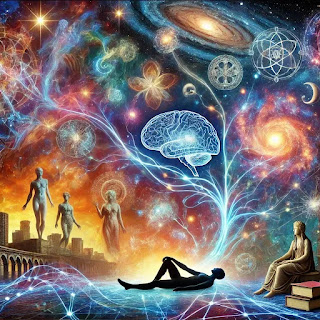The World in the Vacant Space
The concept of "World in the Vacant Space" can be interpreted in various ways depending on the context, such as in science, philosophy, art, or metaphysics. Below are some potential interpretations and details:
1. Physics and Cosmology
In physics, the idea of a "vacant space" often refers to the vacuum of space, which might appear to be empty but is far from it. Here’s a breakdown:
Vacuum Fluctuations: Even in a perfect vacuum, quantum mechanics suggests that particles and antiparticles can spontaneously appear and annihilate. These fluctuations are a core feature of quantum field theory.
Dark Matter and Dark Energy: Vacant space in the universe isn’t entirely empty. It is filled with dark matter and dark energy, which account for about 95% of the universe's total mass-energy content. These are invisible, mysterious forces and particles that we cannot directly observe.
Virtual Particles: The vacuum of space can be teeming with so-called virtual particles. These are temporary particles that appear and disappear, contributing to the overall energy density of space.
2. Philosophical and Metaphysical Interpretation
The notion of a "world in the vacant space" could also be interpreted philosophically or metaphysically, especially in discussions about existence, consciousness, or alternate realities:
Existence & Nothingness: Philosophers like Jean-Paul Sartre have discussed the concept of being and nothingness, suggesting that nothingness is a necessary part of existence. Vacant space could represent the potential for something to emerge.
The Void and Creation: In many spiritual and metaphysical traditions, the "void" or "emptiness" is not seen as mere nothingness, but as a fertile ground for creation and manifestation. It represents a state of pure potential, where all possibilities exist before they materialize.
Alternate Dimensions: The vacant space might be seen as a metaphor for alternate dimensions or parallel worlds. These are theoretical realms that exist alongside our own universe, potentially filled with their own forms of life, energy, and matter.
3. Artistic and Conceptual Ideas
In art or literature, vacant spaces can be filled with meaning:
Negative Space in Art: In visual arts, negative space (or empty space) is often used to highlight the importance of the subject. Artists utilize this space to give balance, create depth, and draw attention to the main elements of their work.
Imaginary Worlds: Writers, filmmakers, and other creators often imagine worlds or realities that exist within the empty spaces of reality. For instance, speculative fiction, science fiction, or surrealism frequently explore the theme of unknown worlds hidden in the "gaps" of known reality.
4. Psychological Interpretation
Psychologically, "vacant space" could represent the unoccupied parts of our mind or unconscious:
Mindfulness and Emptiness: Vacant spaces in the mind, as explored in mindfulness or meditation, are often seen as places of calm and potential growth. In this sense, vacant space can be a mental state where thoughts have not yet formed, allowing for creative insights or mental clarity.
Subconscious World: Some might interpret the vacant space as the realm of the subconscious, where suppressed thoughts, desires, and fears exist outside of our direct awareness, influencing our actions and beliefs in subtle ways.
5. Science Fiction and Futurism
In a more speculative or futuristic view, the idea of a "world in the vacant space" could pertain to space colonization, artificial worlds, or simulations:
Space Colonies: Humans could one day build worlds or habitats in the "vacant spaces" of the universe, such as artificial space stations, colonies on moons or asteroids, or in massive, hollow structures like Dyson spheres.
Simulated Worlds: Another possible interpretation is the idea that vacant space could be filled with virtual or simulated realities. In the future, we might develop highly advanced simulations that create entire worlds within a digital space.
Conclusion:
The idea of a "World in the Vacant Space" is a rich and versatile concept that can apply to multiple fields of thought, including physics, philosophy, art, and psychology. It can refer to everything from the mysterious aspects of quantum physics to alternate realities and the potential within emptiness for creation and exploration.




Comments